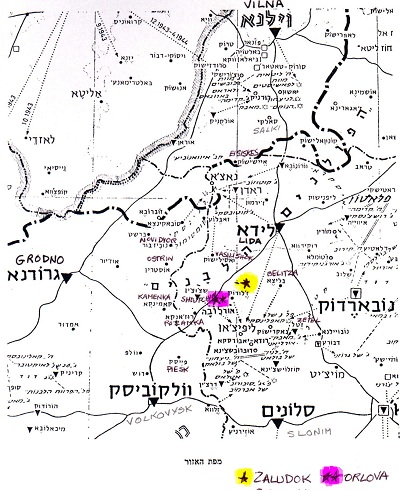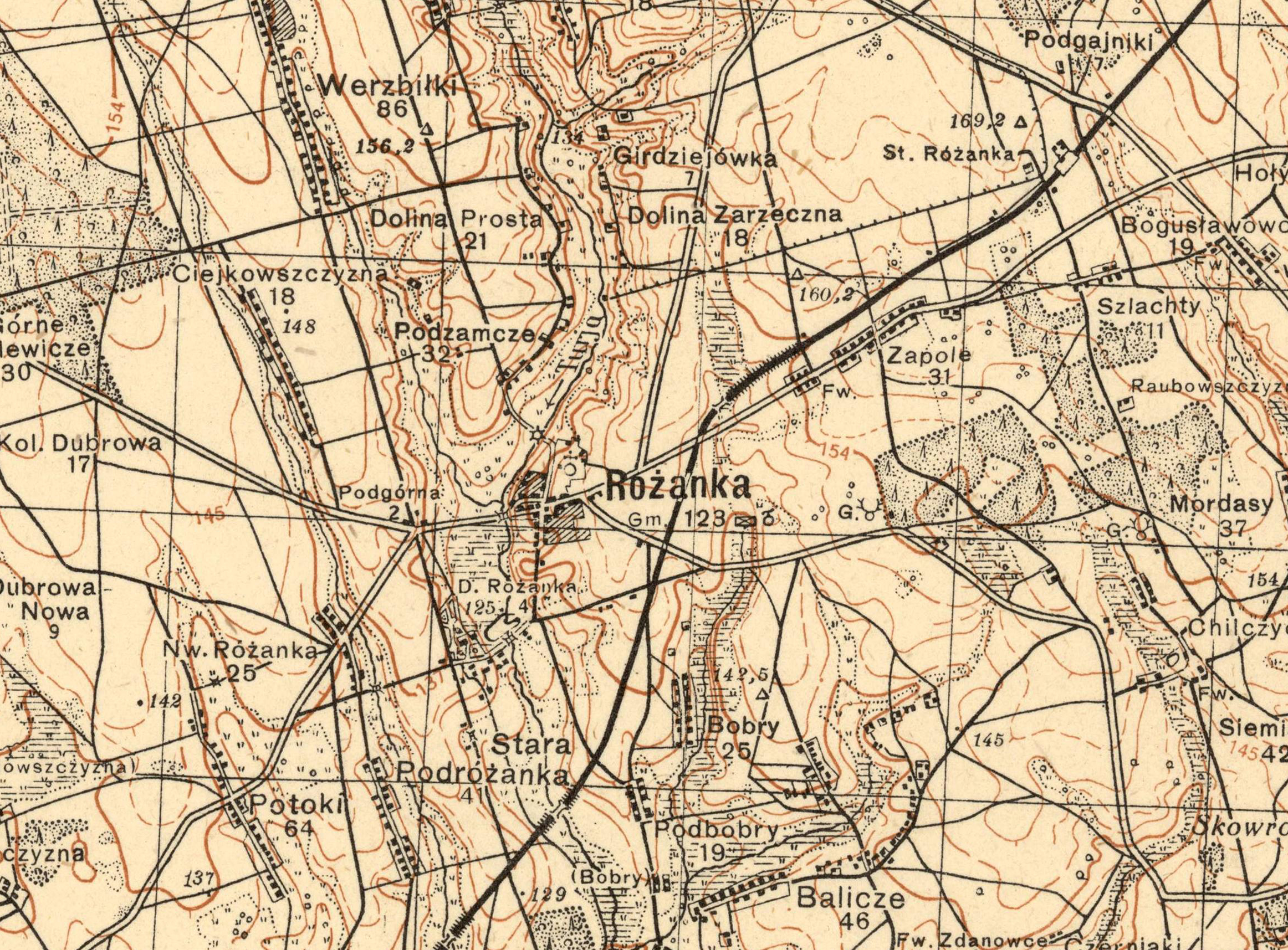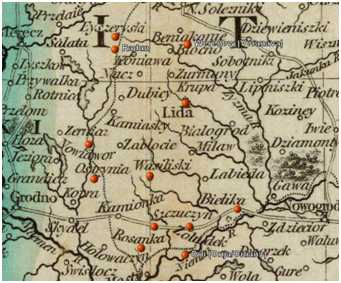 ROZANKA ROZANKA
Alternate names: Rozanka
[Rus, Yid], Różanka [Pol],
Ražanka [Bel], Ruzhanka,
Russian: Рожанка. Belarusian: Ражанка. רוז'אנקה Hebrew, ראזשאנקע
Yiddish. 53°32' N, 24°44' E, 33 miles SW of Lida, 6
miles S of Scucyn. 1900 Jewish population: 543. Hrodzyenskaya Voblasts'
and the dependent villages of Balicze, Bobra, Bolotniki, Ciejkowszczyzna,
Chilczyce and I, II, III, and IV, Cierechy, Dolina Prosta, Dolina
Zarzeczna, Dolne I Gorne, Dowklewszczyzna, Dzerniaki, Dziakowce,
Filipowicze, Girdziejowka, Holownicze, Holynka, Karpiejdzyki,
Karpiowicze. Klimowszczyzna, Kolonya Dubruva, Krupowo, Kryszylki,
Lahody and I and II, Makijowce/Makhovichi at 5349 2510, Malewicze
Gorne, Mordasy, Nowinka, Nowo-Rozanka, Obsoch, Onichowszczyzna,
Perekop, Podgajniki, Podgorna, Podrozanka, Podzamcze, Poplawy, Potoka,
Pozniakowszczyzna, Rakovichi/Rakowica/Rakowicze, Rezy, Rozanka Nowa,
Rucznica, Ruczyce, Rusaki, Siemiaeniaki, Siemiagi, Stara Podrozanka,
Suchary, Szlachty, Trochimczyki, Turowka, Walanczyce, Wierzbilki,
Woroniszki, Zaborze, Zapole
and the estates, colonies, and
hamlets of Boguslawowo,
Borki and I, II and III, Ciejkowszczyzna, Dzierazno, Dubrowa, Dubrowa
Nowa, Girdziejowka, Girejowska, Mokrzyce, Onichowszczyzna, Podbobra,
Poplawy, Potoka, Prostanasczyzna, Race, Rakowicze, Rutkiewicze,
Turya/Turia, Uniebowszdzyna, Zdanowce
Slownik
Geograficzny Krolestwa Polskiego, p. 854:
Rozanka, 1. Mko rz?d. Nad
Turejka, pow. lidzki, w 3 okr. Pol., gm. i okr. wiejski Rozanka, o 56
w. od Lidy a 144 w. od Wilna, ma 833 mk. (445 m?z. i 438 kob.). Ko?cio?
par. Katol. p.w. ?w. Piotra I Paw?a z muru wzniesiony w 1764 r. przez
wojewod? Paca. Par. kat., dek. lidzkiego, 2097 wiernych; kaplica na
cmentarzu grzebalnym. Okolica cz??ci? wynios?a, cz??ci? za? r?wna,
grunt zwirowaty, las?w ma?o. Dziedzictwo niegdy? Pac?w, dzi? w?asno??
rz?du, kt?ry ziemi? odda? w?oscianom na wykup. Gmina Rozanka nale?y do
2 okr. Pokojowego do spraw w?o?cia?skich, 2 rewiru powo?anych do s?u?by
wojskowej z pow. lidzkiego oraz 2 okr. s?dow., obejmuje 64 wsi,
maj?cych 351 osad, zamieszka?ych przez 4264 w?o?cian p?ci ob.; sk?ada
si? z 2 okr. wiejskich: Rozanka i Rakowicze. Szkola gminna znajduje si?
w R. (75 uczn.). Pod?ug spisu z 1864 r. by?o w gminie 619 dusz rewiz.
w?osc. uw?aszcz. i 1011 b. w?osc. skarbowych. W sk?ad okr?gu wiejskiego
wchodz?; mko R., wsi: Podzamcze, Dowklewszczyzna, Wierzbilki, Bobra,
Podbobra, Zaborze, Potoka, Nowo-Rozanka, Kryszylki, Dziakowce,
Malewicze Dolne I G?rne, Podr?zanka, Ciejkowszczyzna, Makiowce, Dolina
Zarzeczmowszczyzna, Dolina, Tur?wka; za?c. Krylyszki i Klimowszczyzna,
oraz kolonia ?yd?w rolnik?w Malewicze, w og?le w 1864 r 838 dusz rewiz.
b. w?o?cian skarbow. 2.) R. Nowa, w? w?o?c., pow. lidzki, w 3 okr.
pol., gm., okr. wiejski Rozanka, 2 dusze rewiz. 2.) R. Nowa J. Krz.
small
town official government above the TUREJKA [river], in Lida powiat, in
the third Polish rural administrative district and commune Rozanka,
about 56 wiorsts [59.752 km] from Lida and 144 wiorsts [153.648 km]
from Wilna, has 883 inhabitants (445 males and 438 female), Catholic
church building dedicated to Sts. Peter and Paul built of brick in 1764
by voivode [a rank] Pa. Catholic parish, deanery [actually decanate; a
grouping of 10 parishes] in Lida, 2,097 parishioners; [also] chapel on
cemetery grounds. The terrain is hilly, the soil gravelly, there are
few forests. Once in the hereditary ownership of the Pac family, the
government has ransomed the land back to the peasants. The township
Rozanka belongs to 2 peaceful districts of peasant affairs, 2
conscription rewiru into military service with Lida powiat
[administrative division comparable to German Kreis] as well as 2
district seats, obejmuje 64 villages, majacych 351 settlers, residents
over 4,264 peasant plci; composed of 2 rural districts: Rozanka and
Rakowicze. Township school found in Rozanka. (75 students). According
to list [census?] of 1864 619 affranchised peasants and 1011 financial
peasants. The rural district includes: miasteczko [small town] Rozanka,
villages: Podzamcze, Dowklewszczyzna, Wierzbilki, Bobra, Podbobra,
Zaborze, Potoka, Nowo-Roznka, Kryszylki, Dziakowce, Malewicze Dolne and
Gorne, Podrozanka, Ciejkowszczuzna, Makowce, Dolina Zarzeczna, Dolina,
Turowka; settlement of lesser nobility or yeomen Krylyszki and
Klimowszczyzna, as well as Jewish farming colony *Malewicze/ Malivitzia
- a Rozhanka Jewish farming colony founded about 1864 was part of gmina
"Rozhankovskaya", povet Stchutchinki, Novogrudskoe voedvostvo, Poland
in 1932.
- Nowa Rozanka,
ws wlosc.,
pow. Lidzki, w 3 okr. Pol., gm., okr.wiejski Rozanka, 2 dusze rewiz. New
Rozanka, peasant or farming village, Lida district, in three Polish
districts, rural parish district, two revisions. [Translation
by Jan Sekta and Ellen Sadove Renck].
- Malewicze-
a Rozhanka Jewish farming colony founded about 1864 was part of gmina
Rozhankovskaya , povet Stchutchinki, Novogrudskoe voedvostvo, Poland in
1932.
- Potoka,
village of Rozanka, p. 871: 1.)
w?. w?osc., pow. Lidzki, w 3 okr. pol., gm., okr. wiejski i dobra
skarbowe Rozanka, o 58 w. od Lidy, 15 dm., 190 mk. (93 dusz rewiz.). J.
Krz. [peasant or farming village, Lida powiat, in third
Polish district, rural district and public property Rozanka, 58 wiorsts
from Lida, 15 houses, 190 inhabitants (93 in revision list) J. Krz]
- 1932: Potoki
wies (village) was in gmina Rozhankovskaya, povet
Stchutchinki, Novogrudskoe Voevodstvo) [Translation by Jan Sekta and
Ellen Sadove Renck].
- Różanka-Nowa,
a peasant village, Lida district, was in the 3rd police precinct,
Różanka rural precinct, 2 male serfs.
[Translation by Jan Sekta and Ellen Sadove
Renck].
 1927
map of Rozanka 1927
map of Rozanka
Current
Rozanka map.
Scucyn's closest neighbor is Rozanka,
which before the division of Poland, was the estate of the well-known
nobles of the house of Patz. The town thus was called "Rozanka-Patzovska",
to distinguish it from another Rozanka. General
Patz defeated the armies of Bogdan Chmielnitsky in the year 1650,
saving Vilna and Grodno from invasion by Cossacks. (A common assumption
is that the Patz Family's origin is Jewish.) In 1764, the Viavoda
(General) of the House of Patz established the luxurious Cathedral of
the Apostles Peter and Paul in Rozanka. During the 1830's, Rozanka was
confiscated from the House of Patz because they participated in the
Polish Rebellion against the Russians. During the 1860's, when Czar
Alexander II freed the serfs, the lands of Rozanka were given to the
serfs on the condition that they would repay the price at long-term
payments. Few Jews lived in Rozanka. Their settlement there started
during the 1880's, when the Railway Line passing nearby was laid.
However, a few Jews had started an agricultural settlement in nearby
Malivitzia in the 1860s. The mestechko of Rozanka in 1899 belonged to
Slonim Uezd (second stan), and according to the territory divisions,
was the main city of Rozhanskaya Volostj and the central post office
for the surrounding small villages. Potoka, in Lida district, then was
in Vilenskaya Guberniya. The Vilenskaya Gubernya "book" is in the
Library of Grodno Museum.
In 1928, Rozanka was designated as a
miasteczko (small town) and gmina wiejska (parish town) in the Second
Uchastok, Lida powiat, Nowogrodskie voevodstvo of Poland. The Justice
of the Peace was in Scucyn and the Justice Court in Vilna. The 1928
miasteczko population was 734. The railway station was three kilometers
away in Rozanka n. Niemnen, on the Mosty-Lida line. the post office and
telegraph were in Rozanka and the telephone in Mosty. Rozanka had one
Catholic church, one synagogue, and mills. Imenie "Rozanka", now the
building of the secondary school, in 1928, belonged to R.K.
Kobordo-Mernicheg. Rozhankovskaya gmina, Lidski povet. In 1972, Rozanka
was a village in Scucyn District of Grodno Region, 7 km from Scucyn, 74
km from Grodno and 4 km from Rozanka railway station, On the Mosty to
Scucyn road. Rozanka had a tractor repair workshop, a wood-cut
workshop, one secondary school, a House of Culture, a library, a
kindergarten, a hospital, a post-office, four shops, and one monument
to those who died in the WWII. (Soviet Belorussian Encyclopedia-1972)
A brick synagogue in the center of Rozanka
still exists [1998] but was made into an Orthodox church during the
summer of 1998. The Jewish cemetery does not exist. Some of the
gravestones are visible in the river. The Jews of Rozanka were shot at
a place in Scucyn. Source: Scucyn Yizkor Book
LOCATION AFTER 1939: Baranavichy
Oblast (Belarusian: Баранавіцкая вобласць, Russian:
Барановичская Область) was a territorial unit in the Belarusian Soviet
Socialist Republic created after the annexation of West Belarus into
the BSSR in November 1939. The administrative centre of the province
was the city of Baranavichy. The voblast was originally known as the Navahrudak
Voblast but it was soon renamed to Baranavichy Voblast. The
oblast was made up of 26 raions in 1944. These raions were
Byten, Gorodyshche, Ivyanets, Iwye, Yuratishki, Karelichy, Kletsk,
Kozlovshchina, Lyakhavichy, Lida, Lubcha, Mir, Masty, Navahrudak, Nova
Mysh, Nesvizh, Radun, Slonim, Stowbtsy, Shchuchyn, Vasilishki,
Valozhyn, Voranava, Dzyatlava, Zel’va and Zheludok.
In 1944, the oblast was diminished after transferring raions
of Lida, Radun, Schuchyn, Vasilishki, Voranava, Masty, Zel’va
and Zheludok to newly founded Hrodna Voblast (Founded after
remaining parts of Belastok Region to Belarus in 1945) and ones
of Iwye, Yuratishki and Valozhyn to Molodechno Voblast in
1944. Finally on January 8, 1954 the oblast was liquidated and the
raions were divided between the Brest (Raions of Gorodyshche,
Lyakhavichy and Novo Mysh), Grodno (Byten, Karelichi, Kozlovshchina,
Lubcha, Mir, Navahrudak and Slonim), Molodechno (liquidated in 1960)
(Raion of Ivyanets) and Minsk (Raions of Kletsk, Nesvizh and Stowbtsy)
Olbasts (Modern Brest Voblast, Hrodna Voblast and Minsk Voblast). Thus,
Baranavichy became part of Brest one as raion center after Nova Mysh
one's center was moved to Baranavichy in 1 May 1954 and renaming it as
Baranavichy one after 8 April 1957. Today:
Radun is in Voranava District, Hrodna Voblast, Belarus.
RÓŻANKA (SLOWNIK
GEOGRAFICZNY TRANSLATION): J . Krz .(Slownik, VOL. IX, P.
854) [FEB 2013]
A government-owned town on the Turejka
River, Lida district, in the 3rd police precinct, Różanka
gmina and rural precinct, at 56 wiorsts [approx. 56 km] from Lida and
144 w. from Wilno, has 883 inhabitants (445 male and 438 female).
Catholic parish church called by the name of Ss. Peter and Paul, with
high brick walls, founded in 1764 through wojewód[Polish
senator] Pac. Catholic parish, Lida deanery, has 2,097 faithful; chapel
in the burial ground. The environs have an elevated section and a level
section, gravelly cultivated land, small forests. Once upon a time the
inheritance of Pac, today [Różanka is] a governmental estate
whose lands were turned over to the peasants to buy back.
Różanka gmina belongs to the 2nd peace district of peasant
affairs, 2nd circuit of summons to military service from Lida district,
and 2nd court district. Encompassing 64 villages, having 351
settlements, 4,264 peasants (both sexes) reside there. It takes in two
rural districts: Różanka and Rakowicze. A gmina school is
found in Różanka (75 students). According to the rolls of
1864, there were in the gmina 619 dusz reviz. ["revision souls," or
male serfs] who were enfranchised peasants and 1,011 who were treasury
peasants. In the composition of the rural district come the town of
Różanka and the villages of Podzameze, Dowklewszczyzna,
Wierzbiłki, Bobra, Podbobra, Zaborze, Potoka, Nowo-Różanka,
Kryszyłki, Dziakowce, Malewicze Dolne and Górne,
Podróżanka, Ciejkowszczyzna, Makiowce, Dolina Zarzeczna,
Dolina, Turówka, and the zaścianki [nobility neighborhoods]
Kryłyszki and Klimowszczyzna, as well as the Jewish agricultural colony
Malewicze; in sum, in the year 1864, 838 male serfs who were treasury
peasants.
- Barbara Proko's translation of the Slownik
entry.
- Memoir of Jerome Robbins
- Rozanka is mentioned in the footnotes
to
Wonder
of Wonders: A Cultural History of Fiddler on the Roof by
Alisa Solomon, NY: Holt & Co, 2013
- The story of the Patz family and
their Rozhanka estate In Russian. If you can translate
this, please contact Ellen
Sadove Renck
- Kagan Haprenumerantn
8143; EVREISKAYA ENCY.: XIII: 572
[4 lines]. Documentary Sources on Jewish History in the Archives of the
CIS and the Baltic States
- Preliminary List of collections, Compiled by
Dmitri A. Elyashevich, Acropolis, St. Petersburg: 1994, St. Peterburg
Jewish University, Diaspora Research Institute, Russian State
University for the Humanities, Historical Archival Institute, Center
for Archival research. Grodno (Belarus), Belorussian Historical Archive
in Grodno: 167 Rozankovskaya Synagogue in Lidski uezd. #33, 10
chronicles, 1897-1900
- Yad Vashem: 6174, Yiddish, 1 Oct 1961,
Meirowitz, Mordechai: "actions" in ROZANKA; escape from the Ghetto to
RORELICZE, looting by the local population; abuse of Rav Israel
VIERNICK and burning of Torah scrolls; concentration of remnants of
TURZEC, IWIENIEC, KORELICZE, HONODYSZCZE, and ZDZIECIOL
[Zhetel/Dyatlavo] in the Nowogrodek ghetto; slaughter and "actions";
counting graves; work camp in place; stockpiling weapons and digging
tunnel; escape to partisans in Naliboki city; family camp under the
command of the brothers Bieski; sacrifices of the partisans and only
those that remained alive; revenge on the Belarussian murderers
- Yad Vashem: 62388, Yiddish, MEIROWITZ,
Mordechai: expulsion of Jews from ROZANKA and the cities around Lida to
the ghetto SZCZUCZYN and Novogrodek; tunnel digging in Novogrodek
ghetto and escape by way of the partisans; relations with Jewish
partisans
- Grodno
Region Department, Director: Miss Karina Botrakova, National
Belorussian Historical Archives of Grodno and National Belorussian
Historical Archives, Grodno Region Department, Teizengauz Ploschad 2,
Grodno 230001Belarus
- JGFF:
JewishGen Family Finder
- Don't neglect online genealogy databases
- Yizkor:
Sefer zikaron le-kehilot Szczuczyn, Wasiliszki, Ostryna, Nowy-Dwor,
Rozanka (Tel Aviv, 1966). Rozanka portion:
- Ksiega
Adresowa Handlowa, Warszawa Bydgoszcz 1929
- 1923/ Glowny Urzad Statystyczny
Rzechzypospolitej polskiej
- Slownik
Geograficzny Krolestwa Polskiego
-
Lida
Holocaust Foundation (formerly Lida Memorial Society)
- IAJGS Cemetery Project
- YIVO's
on-line photograph collection
- Collective
reprisal in Rozanka, June 28, 1941
- Grodno Region Department, National Belorussian
Historical Archives of Grodno and
National Belorussian Historical Archives, Grodno Region Department,
Director: eizengauz Ploschad 2, Grodno 230001 Belarus. Those records
can be found in the ALD
- Ksiega Adresowa Handlowa, Warszawa Bydgoszcz
1929
- Glowny Urzad Statystyczny Rzechzypospolitej
polskiej
- EVREISKAYA ENCY.:
- Encyclopedia
Judaica - the online version was formerly free, but is now
subscription. Larger libraries may have the paper version, while some
have subscriptions to the online version.
- Yahadut
Lita
- Yad
Vashem as of 2022, the Rozanka page is at https://www.yadvashem.org/untoldstories/database/index.asp?cid=1173 If past history is any guide, it will soon change
- Satellite map of Rozanka
and vicinity
- Holocaust photo of men captured & about to be executed in Rozanka for having pointed out Nazis to the Soviets.
- A Holocaust blog
has Holocaust photos from Rozanka - use the search feature. It is
well-sourced. i can't predict how much beyond 2020 it will be available.
Vital
Records: The records shown below may already have been
translated. Check
with the Lida District Research Group before your consider
ordering records.
Grodno Archive:
Fond #170, Rozankovskaya Synagogue in Lidski uezd. #33, 10 chronicles,
1897-1900
Fond 33 Synagogue in Rozhanka, Lida yezd, Vilna gub. 10 chronicles
1897-1900
1. Metrical book of divorce 1897 #28
2. " 1898 #20
3. " birth? 1899 #20
4. " 1900 #20
5. " death 1897 #40
6. " 1898 #70
7. " 1899 #70
8. " 1900 #30
9. " marriage 1897 #30
10. " 1898 #40
33 Fond 10 chronicles 1897-1900 Vilna Guberniya
Inv#1--2 Metrical Book of Divorce-Synagogue in Rozhanka 1898
20 Rozhanka Lida yezd, Vilnja Gub
33 Fond 10 chronicles 1897-1900 Vilna Guberniya
Inv#1--3 Metrical Book of Divorce?-Synagogue in Rozhanka 1899
20 Rozhanka Lida yezd, Vilnja Gub
33 Fond 10 chronicles 1897-1900 Vilna Guberniya
Inv#1--4 Metrical Book of Divorce-Synagogue in Rozhanka 1900
20 Rozhanka Lida yezd, Vilnja Gub
33 Fond 10 chronicles 1897-1900 Vilna Guberniya
Inv#1--1 Metrical Book of Divorce-Synagogue in Rozhanka 1897
28 Rozhanka Lida yezd, Vilnja Gub
33 Fond 10 chronicles 1897-1900 Vilna Guberniya
Inv#1--9 Metrical Book of Marriage-Synagogue in Rozanka 1897
30 Rozhanka Lida yezd, Vilnja Gub
33 Fond 10 chronicles 1897-1900 Vilna Guberniya
Inv#1--5 Metrical Book of Death-Synagogue in Rozhanka 1897
40 Rozhanka Lida yezd, Vilnja Gub
33 Fond 10 chronicles 1897-1900 Vilna Guberniya
Inv#1--8 Metrical Book of Death-Synagogue in Rozhanka 1900
40 Rozhanka Lida yezd, Vilnja Gub
33 Fond 10 chronicles 1897-1900 Vilna Guberniya
Inv#1--10 Metrical Book of Marriage-Synagogue in Rozanka 1898
40 Rozhanka Lida yezd, Vilnja Gub
33 Fond 10 chronicles 1897-1900 Vilna Guberniya
Inv#1--6 Metrical Book of Death-Synagogue in Rozhanka 1898
70 Rozhanka Lida yezd, Vilnja Gub
33 Fond 10 chronicles 1897-1900 Vilna Guberniya
Inv#1--7 Metrical Book of Death-Synagogue in Rozhanka 1899
70 Rozhanka Lida yezd, Vilnja Gub
Address: Grodno Region
Department, Director: Miss Karina Botrakova, National Belorussian
Historical Archives of Grodno
and
National Belorussian Historical Archives, Grodno Region Department,
Director: Miss Karina Brotrakova
Teizengauz Ploschad 2, Grodno 230001Belarus
If
you have Lida uezd
materials to share, please considering donating it.
If you read Yiddish or Hebrew, please contact us.
Records are
held both in Grodno and Vilna archives.For Lida records translation,
your tax deductible contribution by credit card via the secure server
at either group or by mail will grow our knowledge. For a $100
donation, you receive all these records translated two years ahead of
their posting on JewishGen. Every penny collected is used for Lida uezd
projects only. Records include censuses; family lists; marriages,
births, death records; prenumeraten lists; and more. Please contact Judy Baston
with any questions.For current translations, please see the ALD:
All Lithuanian Database and Belarus
SIG Database.
|

